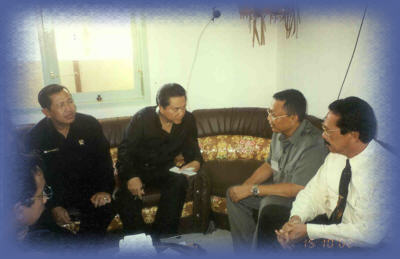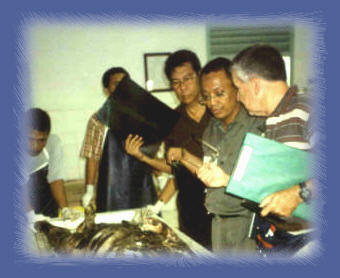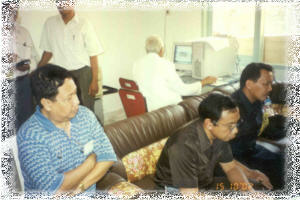[back]
BALI BOMB DVI CASE REPORT
by
the Chairman of the Indonesian Disaster Victim Identification (DVI) Team
dr. EDDY SAPARWOKO, Sp
JP,MM,DFM (former
Sespusdokkes
Polri)
"The
Bali bomb blast on October 12, 2002, was a tragedy that hurt
humanity.
We cannot do anything to change the fact,
we cannot put the life back to the deceased,
nothing much we can offer to relieve the grief of the deceased' friends
and families,
we just try to do our best to identify the bodies, hand in hand with our
colleagues who, like us, volunteered from many different parts of the
world." - putkes
With the
support of International experts The Indonesian DVI Team manage to identify
199 bodies of 202 (98.51%)
The purpose of this report is to provide information to the Indonesian National Police Chief and Staff about the role of Pusdokkes Polri (the Indonesian Police Medical and Health Centre) in order to support the Indonesian Police operational efforts in the identification of the Kuta Bali bomb blast victims by the formation of the Indonesian Disaster Victim Identification Operation Team for Kuta Bali. The goal of this report is to be used as reference for further consideration of the Chief and Staff in policy making regarding the responsibility of the Indonesian DVI Team in the future as well as efforts in the development of Indonesian Police Medicine in supporting the operational police duties .

KombesPol Dr
Eddy Saparwoko (2nd right) during Coordination and discussions with the
Chief of the Investigation Team, Irjen Pol. I Made Mangku Pastika
The identification
procedures were carried out everyday since 13 October 2002 from 08.00
s/d 18.00 WITA (Central Indonesian Time at Sanglah General Hospital, Denpasar, Bali.
Those involved in the DVI Operation
The identification were
carried out by the Indonesian DVI Team which members were came from
various institutions with full support from the Indonesian Police Centre
for Medical and Health Service (Pusdokkes Polri) colaborated with
the other institutions:
a. Pusdokkes Polri
b. Disdokkes Polda Metro Jaya
c. Disdokkes Polda Jateng
d. Disdokkes Polda Jatim
e. Disdokkes Polda Bali
f. Disdokkes Polda Sulsel
g. Depkes RI
i. FK Universitas Indonesia
j. FK Universitas Pajajaran
k. FK Universitas Diponegoro
l. FK Universitas Airlangga
m. FK UniversitasUdayana
n. FK Universitas Saraswati.
Monday 14 Oct 2002 some of Australian experts arrived in Bali and then more experts from Australia and various friendly countries arrived to give a hand, they were:
a. Australian DVI Team 18 experts
b. Hongkong SAR 2 experts
c. Sweden 3 experts
d. Finlands 1 experts
e. Japan 7 experts
f. Taiwan 6 experts
g. The Netherlands 6 experts

Sr Supt Dr Eddy Saparwoko
(the Chairman of the Indonesian DVI Team/ Wadirdokkes Polri - 2nd right),
Sr Supt Dr Slamet Purnomo (the Head of Central Java Police Medical and
Health Servc - 3rd right), and Dr Hilton from Australia (most right)
examined one of the victims.
The Identification
operation were carried out by experts from various countries that had DVI
Teams Kegiatan identifikasi
dilaksanakan oleh personil dari beberapa negara yang memiliki Tim DVI
dengan membentuk beberapa unit, yaitu :
a. Ante Mortem Unit.
b. Post Mortem Unit.
c. Matching Unit.
d. Reconsiliation Comission Unit.
e. Body Release Admin Unit.
f. Supporting Unit.
The Methods used for the Identification Procedures were:
a. Simple - Visual, Victims
Properties, Clothing, ID Cards.
b. Results of the above simple methods then confirmed with Scientific
Methods such as: Fingerprints, Dental data, Medical data, Serology and DNA.
This procedures done using the procedures and forms of DVI Interpol which is the internationally acknowledged standard. (see Procedures Chart [English] [Indonesian] )
The total numbers of
fatalities were 202 persons which consisted of various nationalities and
which were reported as missing, they were: Indonesians, Australians
(highest number), Dutch, Denmark, Japanese, Taiwanese, Koreans, British,
Americans, etc.
In short, what had been done in this operation were:
a. Formation of DVI Team of Legian Kuta Bali Case which were a
collaboration of Indonesian Team and personnels from various friendly
countries.
b. This worked amazingly solid and concentrated on the accuration of
identification and the identification procedures were done using the
international standard (Interpol's).
d. On 29 October 2002 as the follow up the DVI Bali Team was formed, headed by Kabiddokkes Polda Bali AKBP Drg. Agus Sriyono.
e. Then the Identification Operation handed to the DVI Bali Team by the Indonesian DVI Team on 31 October 2002.
There were several constrains faced by the Team :
a. The traditional Balinese
community were against the presence of the bodies in the Hospital for a
long time, they wanted the bodies to be cremated or burried within a short
time.
b. The identification procedures needed accuracy while the conditions of
the bodies were heavily burnt, so that it was impossible to shortened the
time.
c. Bodies decomposition continued and it caused effects such as the
occurence of the bad smell and being the source of diseases.
d. Even though the ante mortem data collected were very helpful, the
process of the collection was not fast enough.

Sr Supt Dr. Musaddeq
Ishaq, DFM, (the Head of East Java Police Medical and Health Servc - left)
took part in the discussions and more discussions on the process of
identifying the heavily burnt bodies.